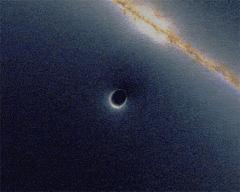
Back Swartkolk Afrikaans Schwarzes Loch ALS Forato negro AN कृष्ण विवर ANP ثقب أسود Arabic محفر كحل ARY ثقب أسود ARZ কৃষ্ণগহ্বৰ Assamese Furacu negru AST Qara dəlik Azerbaijani

A black hole is a region of space-time from which nothing, not even light, can escape. According to the general theory of relativity,[3] it starts existing when spacetime gets curved by a huge mass. There is a sphere around the black hole. If something goes inside the sphere, it cannot leave. This sphere is called the event horizon. A black hole is black because it absorbs all the light that hits it. It reflects nothing, just like a perfect black body in thermodynamics. Under quantum mechanics, black holes have a temperature and emit Hawking radiation, which makes them slowly get smaller.
Because black holes are very hard to see, people find them by the way they affect other things near them. The place where there is a black hole can be found by tracking the movement of stars that orbit somewhere in space. Or people can find it when gas falls into a black hole, because the gas heats up and is very bright. This can be found by telescopes on Earth or by Earth-orbiting telescopes such as Chandra or XMM Newton. Inside a black hole the rules of physics are very different.[4]
Astronomers have found evidence of supermassive black holes at the center of almost all galaxies. In 2008 astronomers found evidence that a supermassive black hole of more than four million solar masses is near the Sagittarius A* part of the Milky Way galaxy.[5]

- ↑ Overbye, Dennis (2019). "Black hole picture revealed for the first time - Astronomers at last have captured an image of the darkest entities in the cosmos - Comments". The New York Times. Retrieved 10 April 2019.
- ↑ The Event Horizon Telescope Collaboration (2019). "First M87 Event Horizon Telescope Results. I. The Shadow of the Supermassive Black Hole". The Astrophysical Journal Letters. 87 (1): L1. arXiv:1906.11238. Bibcode:2019ApJ...875L...1E. doi:10.3847/2041-8213/ab0ec7. ISSN 2041-8205. S2CID 145906806.
- ↑ Wald, Robert M. 1984. General Relativity. University of Chicago Press. ISBN 978-0-226-87033-5
- ↑ Wald, Robert M. 1992. Space, time, and gravity: the theory of the Big Bang and black holes. University of Chicago Press. ISBN 978-0-226-87029-8
- ↑ "Scientists find proof a black hole is lurking at the centre of our galaxy". Metro. 2018-10-31. Retrieved 2018-10-31.